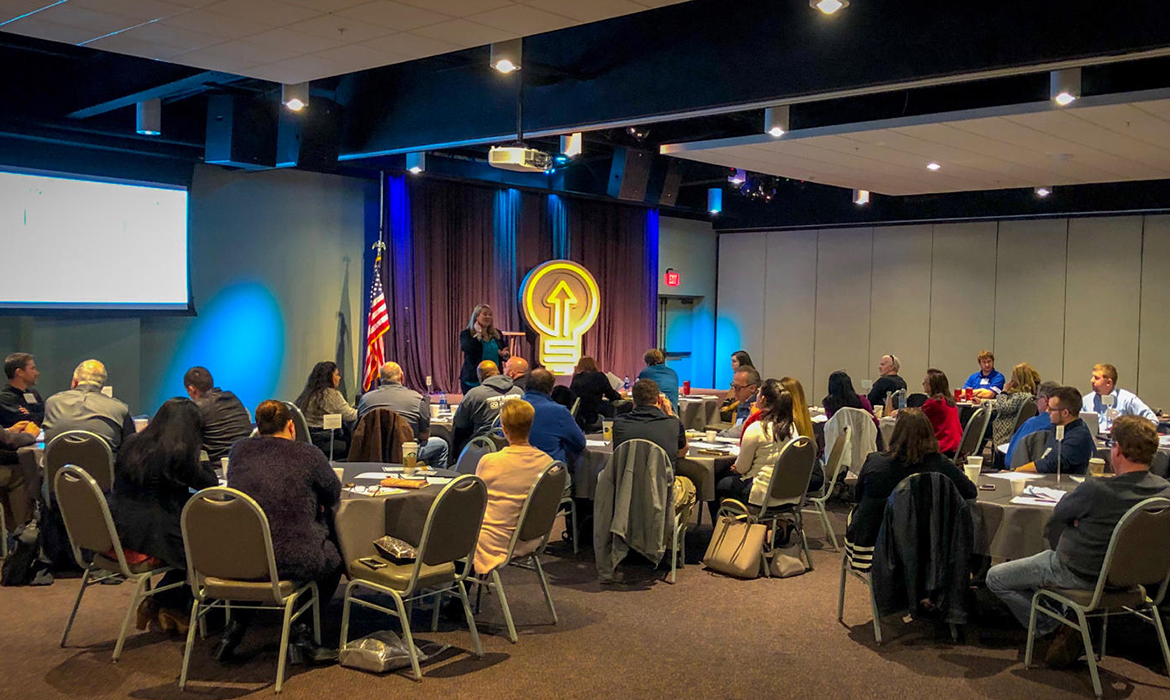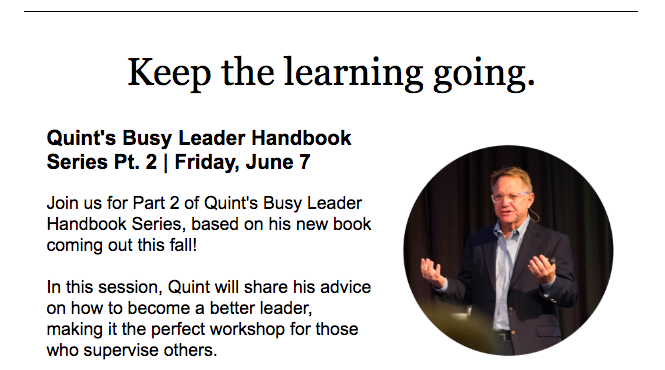Quint's Column: Train when things are going well -- and when they aren't
- May 24, 2019
- / Quint Studer
- / training-development,quint-studer

When money gets tight, what is one of the first things that’s cut or reduced? In my experience, the answer is training and development—if, of course, there are training dollars to cut in the first place. Over the years, I have noticed this paradox: When a business or any organization is not doing as well as they need to or planned to, the first thing they do is cut the training dollars that could help them do better, as well as the travel dollars to get to the training.
Organizations may also neglect training when things are going well. For the most part, I find that leaders and staff are working hard and doing the best they can with what they know. So, it would make sense to invest in training so they can learn to do things even better; yet the opposite takes place. It seems the thinking is, We are doing well, so we are going to not learn how to do better. This mindset is all too common.
I have always felt leaders can learn a lot from physicians. I admire physicians greatly. For a physician to remain board certified, they must attain a certain amount of continuing medical education hours over set time periods. Over the years, physicians have been hit with all sorts of challenges: less reimbursement for the care provided…the need to work harder for the same (or even less) income…the demand for more documentation…higher patient expectations on service…the need to stay up to date with rapidly changing technology and research. Yet, the amount of continuing education they must attain to stay board certified has never been reduced.
Think about why that is. Physicians want to make sure their patients receive the best of care. Imagine that you have a disease and have heard about a new treatment or technique that would provide you a better outcome. And imagine you ask your physician about it and the response is, “We cut training and travel out of our budget, so I am not able to provide that care to you.” You would most likely think that is malpractice!
Yes, leader and staff development mean a financial investment. I use the word “investment” versus the most commonly used word, “expense.” Over the years, I have heard many executives comment that training is expensive. Yet it depends on the outcomes the training will help achieve. I feel the reason training has gotten a bad name or a lack of proper investment at times is due to several factors.
One factor is a lack of clear expectations for attendees. The goal of training is not to have great training. The goal is for people to improve their skills for better personal and workplace performance. Another factor is a lack of follow-up by senior leaders. Often, they don’t implement what was learned and hold people accountable for putting tools and techniques into practice. The most common one I see is senior executives not attending the training and not role modeling what they expect others to do.
This last factor was brought home to me this past week, when I was in Odessa, Texas, to share items on helping leaders create a better community. Rick Napper, a great local CEO, shared the story that years ago when he was in the army, he was selected to be part of a group to learn Total Quality Management from the great W. Edwards Deming. At the first session, the general greeted the attendees, shared his commitment to Total Quality Management, introduced Dr. Deming, and then left the room. Dr. Deming excused himself and followed the general. He then told the general, “If you are leaving, so am I.” The general returned to the training session.
This reminds me of when I did some training at the Cleveland Clinic years ago. The late Dr. Floyd D. Loop was CEO at the time and he was present during the entire two-day session. I remember hearing physicians say this is when they knew the training was really important to the organization.
Over the years, I have made the statement that one can evaluate a person’s and/or company’s values on their commitment to providing the workforce with the training to help them perform. While people may grumble about taking time for training, the great majority appreciate the company’s investment in them. If there are complaints, it’s usually that the training is not good, or that they are not the right people to be in the organization.
For many years, I have owned companies or served them in a top leadership role. In every case, the one budget item that was not open to reduction was training. I believe good training is worth the investment. However, it’s important to realize that the time to recoup the training investment may not happen in 90 days or even in one year. I worry that with so many CEOs’ compensation tied to this quarter of this year’s financial results, short-term decisions are made that negatively impact companies’ longer-term viability.
All that said, here are some tips on how to approach training and development:
Evaluate the organization’s skill set to identify training needs. For people in leadership roles, there are certain “must have” skills. Some of these are selection and onboarding of talent, supervisor best practices, performance feedback, team communication, running good meetings, process improvement, understanding business finances, and the basics of customer service.
Create a short development plan for all leaders and identify skills each staff member needs for the role they are in. Then provide the training opportunities.
Identify the outcomes the training is to impact. For example, if the training is on how to get better at hiring, then turnover should go down after implementing the learnings. Make it very clear that training is an investment with the goal being the desired outcomes.
Training needs to be mandatory, not optional. Optionality hurts an organization.
Top executives must be present during the training. “Do as I say, not as I do” doesn’t get results. As the stories about Dr. Deming and Dr. Loop both demonstrate, being there sends a strong signal to the rest of the organization that the training really matters.
While people from all over read my columns, most of you know I live in Pensacola, Florida. I am a non-paid member of the Studer Community Institute. One of the key services we provide is training and development. I am thrilled to see many local organizations participating in these sessions. In my latest book, Building a Vibrant Community, a chapter is devoted to how skill building has played a strong role in the success and growth of many local start-ups and more established companies. Yet, I am also amazed by the number of organizations that are not participating when cost is low and no travel dollars are needed.
My perception is that in the past, training must not have paid off for these companies, most likely for a number of reasons. Another possibility is that training has never been in place, so the impact has never been experienced. Also, some may be concerned that they themselves will need to change their behavior and they are not willing to do so. I hope these leaders will reconsider the value of training and development.
Back to Rick Napper in Odessa, Texas: I was able to spend time with his leadership team and hear firsthand from staff and managers on how the organization has accomplished some amazing results. The week I was in town, Rick had announced his retirement. Of course, the organization was sad. However, I also watched them feel confident that they would keep the positive momentum going. Why? Because Rick did what a great leader does. He invested in the development of the workforce so that its success would not be dependent on him.
Sun Tzu stated that the expert craftsman leaves no mark. That is also what leaders who work to create a sustainable culture do. The goal is to create an organization that does well even in times of change. That means to approach training not as a nice-to-do but as a must-do. When we train thoroughly and well, we set our people up for success, today, tomorrow, and in the future.
Be sure to sign up for SCI's newsletter to receive updates on new training workshops and events that can help your team grow and thrive.

Learn more and register for Quint's upcoming workshop happening June 7.
 CivicCon launches with a look at good growth in cities
CivicCon launches with a look at good growth in cities
 Building stronger brains one baby, one parent at a time
Building stronger brains one baby, one parent at a time
 SCI debuts commercial on Early Learning City
SCI debuts commercial on Early Learning City
 Entrecon: World class speakers and an opportunity to sharpen skills
Entrecon: World class speakers and an opportunity to sharpen skills
 PYP Quality of Life survey 2017
PYP Quality of Life survey 2017
 EntreCon Pensacola 2016: A look back
EntreCon Pensacola 2016: A look back
 Leadership tip: getting better employee takeaways
Leadership tip: getting better employee takeaways
 Leadership tip: be interested instead of interesting
Leadership tip: be interested instead of interesting
 Leadership tip: delivering difficult messages
Leadership tip: delivering difficult messages
 Brain Bags boost Arc, Early Childhood Court programs
Brain Bags boost Arc, Early Childhood Court programs